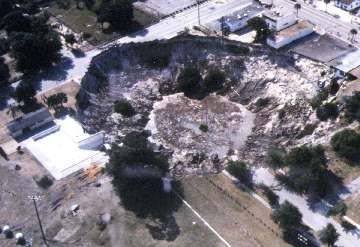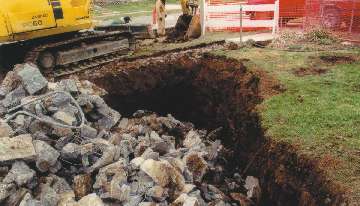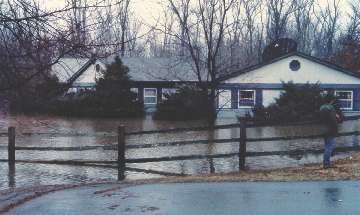mayheader.html

Web
Features
KARST:THE
STEALTHY HAZARD BY JIM COBB AND JIM
CURRENS
|
Fifty-five
percent of the
state of Kentucky sits
atop carbonate rocks
prone to developing
karst. Stressing this
delicate carbonate-
groundwater system
is a growing suburban population
that is
increasing demand
for highways and roads, houses,
airports and factories.
|
 |
In 1981, a sinkhole
in Winter Park, Fla., opened 300 feet by 320 feet around and 90 feet deep
and, in the process, swallowed an entire house, numerous trees, half of
a six-lane highway, half of a public swimming pool, and parts of three
businesses, including parking lots with two Porsches and a pick-up camper—
all in 24 hours. (Florida Geological Survey) |
Infrastructure — buildings and transportation, communication and utility
networks — is vulnerable to damage from a variety of geologic hazards,
such as volcanoes and earthquakes. But karst geohazards are stealthy. They
come silently from below, then unexpectedly make themselves known. And
because they usually affect a segment of a utility line, or one home, or
one short length of highway, their cost is also stealthy. But the toll
adds up.
Karst landscapes and aquifers form when water dissolves limestone, gypsum
and other rocks. The surface expression of karst includes sinkholes, sinking
streams and springs. Kentucky is one of the world’s most famous karst areas.
About 38 percent of the state has sinkholes that are recognizable on topographic
maps, and 25 percent has obvious and well-developed karst features. Much
of the state’s beautiful scenery, particularly the horse farms of the Inner
Bluegrass, is a direct result of the development of a karst landscape.
Many of Kentucky’s cities are built on karst. Springs and wells in karst
areas supply water to tens of thousands of homes. Much of Kentucky’s prime
farmland is underlain by karst, as is a substantial amount of the Daniel
Boone National Forest with its important recreational and timber resources.
Caves are also important karst features, providing recreation and unique
ecosystems. Mammoth Cave is the longest surveyed cave in the world, with
more than 350 miles of passages. Two other caves in the state stretch more
than 30 miles, and nine Kentucky caves are among the 50 longest caves in
the United States.
The economic losses of karst hazards are largely hidden because they
are scattered across an area the size of a state, and individually they
affect small areas when compared to tornado damage, for example. Most people
don’t realize how much they are affected because the costs appear in the
form of higher taxes and an increased cost of living. The cost of repairing
roads, preparing special foundations for large buildings (schools, for
example) and extending public water lines to replace polluted groundwater
all add to the costs of public projects.
Researchers at the Kentucky Geological Survey foresee an increasing
need for research on karst geologic hazards because of the accelerating
pace of suburban development. Delineating karst groundwater basins is vital
to protecting the quality of water discharged from springs and wells, and
is an important tool for understanding the hydrology of sinkhole flooding,
one of the most common karst hazards.
Damaging homes
Karst hazards include sinkhole flooding, sudden cover collapse, leakage
around dams, collapse of lagoons resulting in waste spills and radon infiltration
into homes. Most noticeable are sinkhole flooding and cover collapse. Damage
to infrastructure from these two causes is so common in Kentucky that it
is typically dealt with by local authorities as a routine matter. Seldom
are collapses reported to any central agency.
Sinkhole flooding is one of the more tragic hazards because it affects
private residences the most. Take the house pictured on page 16. Built
in the 1970s, this house has been repeatedly damaged by flooding of a karst
valley (large sinkhole) since 1989. The karst valley in which it was built
is large and was, therefore, at ground level, not recognized as a closed
depression, while the outlet from the karst valley cannot accommodate peak
runoff from upstream. The only way a potential, and very astute, buyer
of this house could be warned of the flooding danger would be by consulting
a topographic map.
Sinkhole flooding usually occurs during the same storms that flood rivers,
so it is sometimes not recognized as karst related. Unlike a normal stream
channel, the karst conduit has a fixed area that cannot increase in cross-section
in response to floods. Because of the loss of energy to friction and the
finite cross-sectional area of the karst conduits, large increases in water
pressure are needed to increase, even by a small amount, the flow in cave
passages.
Sinkholes can also flood when their outlets are clogged, preventing
water from being carried away as fast as it flows in. Trash thrown into
a sinkhole can clog its throat, as can soil eroded from fields and construction
sites or a natural rock fall near the sinkhole’s opening. Sometimes the
conduit itself is too narrow because it has recently (in the geologic sense)
captured a larger drainage basin. The reach of a conduit downstream from
constriction could carry a higher flow than it is receiving were it not
for this restriction. Sinkholes flood more easily around development —
roofs, parking lots, highways — which increases both the total runoff and
the rapidity of runoff from a storm.
A second reason that sinkholes flood is because of backflooding, the
outcome when the discharge capacity of the entire karst conduit network
is exceeded. Some upgradient sinkholes that drain normally during the short,
modest accumulation of storms, may actually become springs that discharge
water during prolonged rainfall.
The Kentucky Department of Emergency Services estimates that a March
1997 flood cost more than $1 million in mitigation costs alone — including
buyouts and construction of stormwater detention basins — for a few counties
in the central and western Kentucky karst areas. Sinkhole flooding in Bowling
Green is well known and has prompted Warren County to enact strict zoning
regulations and building codes.
The state geological survey has been part of efforts to address karst-related
flooding problems in Jessamine County and the cities of Versailles, Lawrenceburg
and Princeton since 1990. Versailles has spent approximately $500,000 to
purchase flood-damaged property in order to take remedial action. The survey’s
experience at these sites suggests that the average annual loss statewide
exceeds $1 million from flood damage alone.
Sudden collapse
Cover collapse occurs when the soil collapses into an underlying grike,
a fissure made larger as water dissolves limestone. Cover collapse is similar
to subsidence, except that it happens suddenly in a small, focused location.

At right: A cover collapse
sinkhole opened under this city sidewalk in Lexington, Ky., on Feb. 19.
The sinkhole is being repaired with a graded filter constructed from broken
concrete from the sidewalk and layers of crushed stone. Leslie K. Russo.
Kentucky Geological Survey.
Both heavy rains or extended droughts can bring on cover collapse. Each
weakens the soil over a grike, either by saturating the soil with water
or robbing it of cohesion. Near buildings, downspouts and leaking utility
pipes can accelerate the process. Eroded soil falls into the grike and
water moves the soil to an underlying cave, forming a cavity in the mantling
soil. In high- flow events, water in the cave may backflood into the overlying
soil. As the water recedes, the cave and grike drain faster than the soil,
which means that saturated soil spans the void in the grike. The overloaded
soil arch falls into the soil cavity and the cover collapses.
The erosion of soil into the underlying conduit does not automatically
stop when an impermeable surface, such as a highway, parking lot or building,
is constructed over the sinkhole. Lateral flow can easily continue to erode
the soil. The typical scenario is when no local ordinance prevents a developer
of a rural subdivision from filling sinkholes. The developer builds a house
on a filled sinkhole from which the fill continues to be undermined. Subsidence
results, sometimes decades after the developer is gone.
Homeowners’ insurance in Kentucky does not pay for subsidence damage,
except for that attributable to underground coal mining in counties where
specified by law. Unlike in Florida, where the cover over the limestone
is very thick, cover-collapse sinkholes in Kentucky are unlikely to swallow
entire buildings. Cover-collapse sinkholes do, however, severely damage
buildings, drain farm ponds, damage roads and utility lines and wreck farming
equipment. Even as we wrote this article, co-author Jim Currens visited
three cover collapse sinkholes, one of them pictured above.
Infrastructure damage
In Kentucky, infrastructure damage from karst has included Wolf Run
Dam on Cumberland Lake in southeastern Kentucky. The dam was constructed
in the 1940s on Lower Mississippian calcareous siltstones interbedded with
reef carbonates, Devonian black shale and Upper Ordovician dolomites. Although
karst conduits and caves were encountered and remediated, the extent of
karst development at the site was not fully recognized during construction.
In the late 1960s, sinkholes developed near the downstream toe of the dam.
Reservoir water was passing beneath the cutoff trench. The problem was
solved with a diaphragm cutoff wall nearly 4,500 feet long and up to 278
feet deep. The repairs cost millions of dollars and could have been avoided
if its original builders had obtained better on-site geological data.
At left: This house was built
in a large karst valley that has flooded repeatedly since 1989. The karst
valley is not recognizable as a closed basin without a topographic map
or knowledge of the surrounding area. James C. Currens, Kentucky Geological
Survey.
Many other reservoirs of all sizes have leaking dams or leakage through
carbonate bedrock around the dam. Leakage through caves passing under the
dam of Shanty Hollow Lake in Warren County and leakage through bedrock
forming the abutment bank of Spa Lake in Logan County are more recent examples
of karst damage. Highways are also vulnerable. In the mid-1990s,
a cover-collapse sinkhole appeared overnight in the northbound lane of
Interstate 65 near Elizabethtown. Fortunately, no one drove into it, but
it did require extensive repairs. Many other collapses have occurred along
state and county roads.
Exceptional costs for highway construction projects and repairs to existing
roadways since 1995 are estimated to exceed a half million dollars a year.
Storm- and sanitary-sewer lines commonly leak, which can trigger cover
collapse and break the utility pipe.
Lessening the hazard
The only certain way to avoid economic and environmental damage from
human activity on karst terrain is to avoid building on karst. But the
demands of economic growth are applying irresistible pressure to develop
the karst lands of Kentucky. Unfortunately, only a few cities and counties
have zoning regulations governing construction in karst terrane. Topographic
maps at a scale of 1:24,000 are available for the entire state, but citizens
and planners sometimes do not recognize the significance of a closed topographic
contour, and businesses and homes continue to be built in sinkholes.
The Kentucky Geological Survey is working on two fronts to reduce the
economic losses from karst terrane. The highest priority is to develop
maps that give specific warning of karst geologic hazards: for example,
maps indicating sinkholes that have a history of flooding. The karst groundwater
basin maps can be used to specifically protect the watersheds of springs
used as water supplies.
The survey has produced six karst groundwater basin maps and plans to
produce more. Groundwater dye tracing is continuing across the state. We
hope to produce quadrangle maps depicting sinkholes that have historical
documentation of flooding, and a second set of maps showing the probability
that the cover of a sinkhole will collapse.
The second approach is public education. The survey is publishing brochures
and posters to distribute to schools and the public.
But the most effective educational tool is to give invited presentations
to planning and zoning boards, city councils and conservation groups dealing
with a karst issue. These groups don’t need to be convinced of the reality
of karst-related geologic hazards, and the knowledge we supply is eagerly
received.
Cobb is the Kentucky State Geologist and
Currens is a Kentucky Geological Survey hydrogeologist who specializes
in karst aquifers. E-mail: currens@kgs.mm.uky.edu
SINKHOLES DEFINED
Geologists classify sinkholes based on
their geometry and how they developed. Understanding sinkhole dynamics
is critical to detecting and mitigating damages these karst features can
cause.
Collapse sinkholes occur when the bridging
material over a subsurface cavern cannot support the overlying material.
The cover collapses into the cavern and a large, funnel-shaped depression
forms.
Solution sinkholes result from increased
groundwater flow into higher porosity zones within the rock, typically
through fractures or joints within the rock. An increase of slightly acidic
surface water into the subsurface continues the slow dissolution of the
rock matrix, resulting in slow subsidence as surface materials fill the
voids.
Alluvial sinkholes are older sinkholes
that
have been partially filled with marine, wetland or soil sediments. These
features are common in Florida, where the water table is shallow, and typically
appear as shallow lakes, cypress “domes” and wetlands.
Raveling sinkholes form when a thick overburden
of sediment over a deep cavern calves into the void and pipes upward toward
the surface. As the overlying material or “plug” erodes into the cavern,
the void migrates upward until the cover can no longer be supported and
then subsidence begins.
Walter Schmidt




